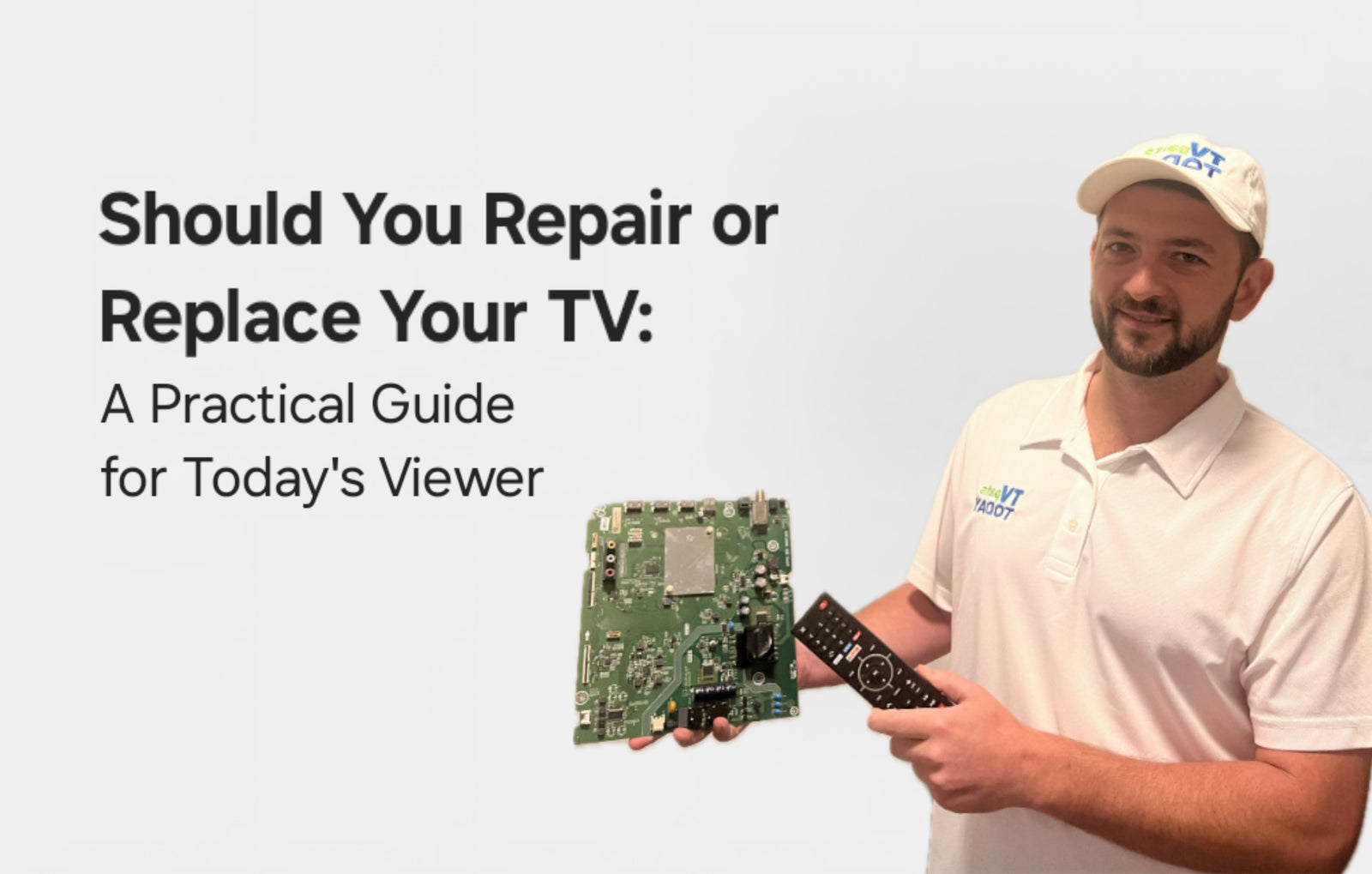In today’s fast-paced tech world, choosing between repairing or replacing your TV isn’t as simple as it used to be. With rising electronics costs due to smarter features, higher resolutions, and pricier materials, consumers are left juggling finances, functionality, and future value. Whether you're facing a minor power board issue or a major screen crack, understanding the cost and longevity of your television is key to making a smart choice.
Would you rather watch a video covering a similar topic? Check out our Troubleshooting 101 video over on YouTube:
The High-Tech Dilemma: Repair or Replace?
As smart TVs become the norm and features like 4K, OLED, and built-in streaming take center stage, the temptation to upgrade is real. But here’s what to consider:
- Cost Efficiency: If your TV is only a few years old and the issue is minor (like a power supply problem), a repair may be your wallet’s best friend.
- Feature Relevance: If you’re still watching on a 1080p set without smart features, an upgrade could offer massive improvements in quality and convenience.
- TV Age: If your unit is pushing 7+ years, even a successful repair may not hold long-term value.
TVpartsToday Tip: Check your TV’s manufacturing date, usually found on the back label — to gauge where it stands in its life cycle.
Understanding the Costs: Common Issues and Repair Pricing
From broken HDMI ports to burnt-out LEDs, the range of TV issues is vast, and so are the costs.
| Problem | Average Repair Cost | Worth Repairing? |
|---|---|---|
| Cracked Screen | $300–$600+ | Usually not |
| Power Supply Failure | $30–$100 (parts) | Often |
| Main Board Replacement | $50–$150+ | Varies |
TVpartsToday Tip: Browse by brand... Samsung, LG, and Sony parts are typically easier to find! However, when you decide to try replacing a part, always match the part number exactly.
Brand Matters: How Repair Costs Differ
Repair prices can vary significantly by brand and model. For example:
- Sony and Samsung: High-end components = higher labor and part costs.
- Insignia, TCL, Sceptre: Budget-friendly brands usually mean cheaper repairs.
Warranties & Service Plans: Worth the Investment?
- Manufacturer Warranties often cover parts and labor for 1–2 years.
- Extended Service Plans may offer 5+ years of coverage for issues like power surges, dead pixels, and even accidental damage.
TVpartsToday Tip: Always keep your receipt and warranty card in a safe place, you’ll need them to file claims.
Is It Time to Replace? Know Your TV’s Lifespan
TVs don’t last forever. Here's a quick reference:
| TV Type | Average Lifespan |
|---|---|
| LED | 4–10 years |
| OLED | 5–8 years |
| QLED | 7–10 years |
To extend your TV’s life:
- Turn it off when not in use.
- Use a surge protector.
- Avoid max brightness settings.
Why Upgrade? Benefits of Modern TVs
The latest TVs aren’t just shinier, they’re smarter, clearer, and greener:
-
4K & 8K Resolutions for stunning clarity
-
Smart Features for built-in streaming and app control
-
Energy Efficiency to lower your electric bill
TVpartsToday Tip: Look for TVs with HDMI 2.1 if you’re into gaming, it supports better refresh rates and low latency.
Think Green: What to Do with Your Old TV
Before you curb that busted flat screen:
- Recycle: Check local recycling programs or retailer take-back services.
- Donate: If it works, give it to a school or charity.
- Part Out: Salvage working parts like remotes, boards, or stands for resale.
TVpartsToday Tip: Search for eco-certified recyclers to ensure proper disposal. If you're in the Evansville, IN area, feel free to bring us your TV for recycling!
Smart Shopping: Save Big on Replacements
If you decide to buy, timing is everything:
- Shop Holiday Sales: Think Black Friday, Super Bowl season, or back-to-school events.
- Subscribe to Deal Alerts: Stay updated on discounts from major retailers.
- Consider Refurbished: Certified refurbished TVs and parts can save you up to 50%.
The Final Call: Repair vs. Replace
When making your decision, consider the Total Cost of Ownership:
- Initial purchase vs. repair costs
- Expected lifespan remaining
- Energy consumption
- Warranty coverage
TVpartsToday Tip: A $100 repair on a 3-year-old TV may be a good deal. But spending $200+ on a 7-year-old model? Probably not! It's all down to a personal calculus everyone has to complete for themselves.
Make a Sustainable, Smart Choice
Balancing performance, cost, and sustainability doesn’t have to be stressful. By evaluating your TV’s condition, researching your repair options, and comparing the cost-benefit of an upgrade, you can make a decision that fits your budget... and the planet!
Need Help?
If you’re still unsure about the issue or need to replace a part, reach out to TVpartsToday. We can help you identify the exact cause of the problem and provide the right replacement part!
Would you rather watch a video? Check out our helpful Troubleshooting 101 playlist over on YouTube!
Would you rather chat with a seasoned repair expert? Head on over to our TVRepairHelp subReddit!
Need help finding the right board or part?
Call us at 930-212-1975 or browse our inventory online.
DIY-friendly parts, fast shipping, and expert support – only at TVpartsToday.


3 comments
My TCL tv was heated accidentally while pulling the remote from my son it doesn’t shows picture but I can see the inner light when I switched on
Plz I’m looking for JVC LCD pl it’s how much I’m in Boksburg
Dark Broad Middle Line appear while functioning TV……..Need your guidance..